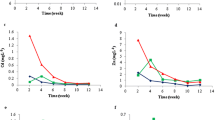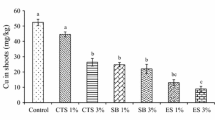Abstract
Liming materials have been used to immobilize heavy metals in contaminated soils. However, no studies have evaluated the use of eggshell waste as a source of calcium carbonate (CaCO3) to immobilize both cadmium (Cd) and lead (Pb) in soils. This study was conducted to evaluate the effectiveness of eggshell waste on the immobilization of Cd and Pb and to determine the metal availability following various single extraction techniques. Incubation experiments were conducted by mixing 0–5% powdered eggshell waste and curing the soil (1,246 mg Pb kg−1 soil and 17 mg Cd kg−1 soil) for 30 days. Five extractants, 0.01 M calcium chloride (CaCl2), 1 M CaCl2, 0.1 M hydrochloric acid (HCl), 0.43 M acetic acid (CH3COOH), and 0.05 M ethylendiaminetetraacetic acid (EDTA), were used to determine the extractability of Cd and Pb following treatments with CaCO3 and eggshell waste. Generally, the extractability of Cd and Pb in the soils decreased in response to treatments with CaCO3 and eggshell waste, regardless of extractant. Using CaCl2 extraction, the lowest Cd concentration was achieved upon both CaCO3 and eggshell waste treatments, while the lowest Pb concentration was observed using HCl extraction. The highest amount of immobilized Cd and Pb was extracted by CH3COOH or EDTA in soils treated with CaCO3 and eggshell waste, indicating that remobilization of Cd and Pb may occur under acidic conditions. Based on the findings obtained, eggshell waste can be used as an alternative to CaCO3 for the immobilization of heavy metals in soils.







Similar content being viewed by others
References
Arunlertaree, C., Kaewsomboon, W., & Kumsopa, A. (2007). Removal of lead from battery manufacturing wastewater by egg shell. The Songklanakarin Journal of Science and Technology, 29, 857–868.
Chen, H. M., Zheng, C. R., & Tu, C. (2000). Chemical methods and phytoremediation of soils contaminated with heavy metals. Chemosphere, 41, 229–234.
Chojnacka, K. (2005). Biosorption of Cr(III) ions by eggshells. Journal of Hazardous Materials, 121(1–3), 167–173.
Cody, R. P., & Smith, J. K. (1991). Applied statistics and the SAS programming language. New Jersey, NJ: Prentice-Hall Inc.
Gupta, A. K., & Sinha, S. (2007). Assessment of single extraction methods for the prediction of bioavailability of metals to Brassica juncea L. Czern. (var. Vaibhav) grown on tannery waste contaminated soil. Journal of Hazardous Materials, 149, 144–150.
Hooda, P. S., & Alloway, B. J. (1993). Effects of time and temperature on the bioavailability of Cd and Pb from sludge-amended soils. European Journal of Soil Science, 44, 97–110.
Hooda, P. S., McNulty, D., Alloway, B. J., & Aitken, M. N. (1997). Plant availability of heavy metals in soils previously amended with heavy applications of sewage sludge. Journal of Science of Food and Agriculture, 73, 446–454.
Houba, V. J. G., Temminghoff, E. J. M., Gaikhorst, G. A., & van Vark, W. (2000). Soil analysis procedures using 0.01 M calcium chloride as extraction reagent. Communications in Soil Science and Plant Analysis, 31(9), 1299–1396.
ISO. (1995). Soil quality, extraction of trace elements soluble in aqua regia. International Organization for Standardization, 11466.
Jamali, M. K., Kazi, T. G., Arain, M. B., Afridi, H. I., Memon, A. R., Jalbani, N., et al. (2008). Use of sewage sludge after liming as fertilizer for maize growth. Pedosphere, 18(2), 203–213.
Jung, J., Jo, H. J., Lee, S. M., Ok, Y. S., & Kim, J. G. (2004). Enhancement of biodegradability of EDTA by gamma-ray treatment. Journal of Radioanalytical and Nuclear Chemistry, 262, 371–374.
Kumpiene, J., Lagerkvist, A., & Maurice, C. (2008). Stabilization of As, Cr, Cu, Pb and Zn in soil using amendments-A review. Waste Management, 28, 215–225.
Luo, C., Shen, Z., & Li, X. (2005). Enhanced phytoextraction of Cu, Pb, Zn and Cd with EDTA and EDDS. Chemosphere, 59, 1–11.
Mench, M., Vangroensveld, J., Lepp, N. M., & Edwards, R. (1998). Physico-chemical aspects and efficiency of trace element immobilization by soil amendments. In J. Vangroensveld & S. D. Cummingham (Eds.), Metal-Contaminated soils: in situ inactivation and phytorestoration (pp. 151–182). Berlin, Germany: Springer-Verlag and R.G. Landes Company.
MIFAFF. (2006). The statistics for consumption of major livestock products. Gwacheon, Korea: Ministry for Food, Agriculture, Forestry and Fisheries.
MOE. (2002). The Korean standard test (KST) methods for soils. Gwacheon, Korea: Korean Ministry of Environment.
MRC. (2007). Annual report: Development of soil cover engineering protocol for remediation of heavy metal contaminated soil. Seoul, Korea: Mine Reclamation Corporation.
NAAS. (2005). Korean soil information system. http://asis.rda.go.kr. Accessed 29 September. National Academy of Agricultural Science, Suwon, Korea.
NIAST. (2000). Method of soil and plant analysis. Suwon, Korea: National Institute of Agricultural Science and Technology.
Ok, Y. S., Chang, S. X., & Feng, Y. (2007a). Sensitivity to acidification of forest soils in two contrasting watersheds in the oil sands region of Alberta. Pedosphere, 17, 747–757.
Ok, Y. S., Lim, J. E. & Moon, D. H. (2010). Stabilization of Pb and Cd contaminated soils and soil quality improvements using waste oyster shells. Environmental Geochemistry and Health, doi:10.1007/s10653-010-9329-3.
Ok, Y. S., Yang, J. E., Zhang, Y. S., Kim, S. J., & Chung, D. Y. (2007b). Heavy metal adsorption by a formulated zeolite-Portland cement mixture. Journal of Hazardous Materials, 147, 91–96.
Palka, K. (2002). Chemical composition and structure of foods. In Z. E. Sikorski (Ed.), Chemical and functional properties of food components (2nd ed., p. 15). Boca Raton, FL: CRC press.
Park, H. J., Jeong, S. W., Yang, J. K., Kim, B. G., & Lee, S. M. (2007). Removal of heavy metals using waste eggshell. Journal of Environmental Sciences, 19, 1436–1441.
Paulsoe, B., Datta, S. P., Rattan, R. K., & Chahonkar, P. K. (2007). Effect of amendments on the extractability, retention and plant uptake of metals on a sewage-irrigated soil. Environmental Pollution, 146, 19–24.
SAS. (2004). SAS user’s guide, version 9.1. Cary, NC: Statistical Analysis System Institute, Inc.
Usman, A. R. A., & Mohamed, H. M. (2009). Effect of microbial inoculation and EDTA on the uptake and translocation of heavy metal by corn and sunflower. Chemosphere, 76, 893–899.
Vidal, M., Lopez-Sanchez, J. F., Sastre, J., Jimenez, G., Dagnac, T., Rubio, R., et al. (1999). Prediction of the impact of the Aznalcollar toxic spill on the trace element contamination of agricultural soils. Science of the Total Environment, 242, 131–148.
Walkley, A., & Black, I. A. (1934). An examination of the Degtjareff method for determining soil organic matter, and a proposed modification of the chromic acid titration method. Soil Science, 37, 29–38.
Wu, L. H., Luo, Y. M., Christie, P., & Wong, M. H. (2003). Effects of EDTA and low molecular weight organic acids on soil solution properties of a heavy metal polluted soil. Chemosphere, 50, 819–822.
Yang, J. E., Kim, H. J., Ok, Y. S., Lee, J. Y., & Park, J. (2007). Treatment of abandoned coal mine discharged waters using lime wastes. Geosciences Journal, 11, 111–114.
Yang, J. E., Lee, W. Y., Ok, Y. S., & Skousen, J. (2009). Soil nutrient bioavailability and nutrient content of pine trees (Pinus thunbergii) in areas impacted by acid deposition in Korea. Environmental Monitoring and Assessment, 157, 43–50.
Yang, J. E., Skousen, J. G., Ok, Y. S., Yoo, K. R., & Kim, H. J. (2006). Reclamation of abandoned coal mine wastes using lime cake by-products in Korea. Mine Water and the Environment, 25, 227–232.
Zaho, X. L., & Masaihiko, S. (2007). Fractionation and solubility of cadmium in paddy soils amended with porous hydrated calcium silicate. Journal of Environmental Sciences, 19, 343–347.
Acknowledgments
This study was supported by the National Research Foundation of Korea Grant funded by the Korean Government (Project number: 2009-0071439, 50%). Incubation experiments were supported by the Cooperative Research Program for Agricultural Science and Technology Development (Project No. 200712104), RDA of Korea. This study was also supported by the Korea Ministry of Environment as “The GAIA Project No. 173-091-003”. Soil sample analysis was supported by a grant from the Institute of Environmental Research, the Research Institute of Agricultural Science and the Central Laboratory of Kangwon National University, Korea. The authors also thank Jung Eun Lim for conducting incubation experiments.
Author information
Authors and Affiliations
Corresponding author
Rights and permissions
About this article
Cite this article
Ok, Y.S., Lee, S.S., Jeon, WT. et al. Application of eggshell waste for the immobilization of cadmium and lead in a contaminated soil. Environ Geochem Health 33 (Suppl 1), 31–39 (2011). https://doi.org/10.1007/s10653-010-9362-2
Received:
Accepted:
Published:
Issue Date:
DOI: https://doi.org/10.1007/s10653-010-9362-2




